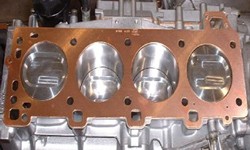Metallic gaskets are mechanical seals designed to fill the space between two or more mating surfaces, primarily in high-pressure, high-temperature, or corrosive environments where non-metallic gaskets may fail. They are crafted from various metals and alloys, offering superior strength, durability, and resistance to extreme conditions. These gaskets are critical components in industries such as oil and gas, chemical processing, power generation, and aerospace, ensuring leak-proof connections in pipelines, flanges, valves, and other equipment. Their ability to maintain a tight seal under fluctuating pressures and temperatures makes them indispensable for safety and efficiency in industrial operations.
Metallic gaskets come in several types, each designed for specific applications and performance criteria. Understanding these variations helps in selecting the right gasket for your needs.
The performance of metallic gaskets heavily depends on the material used. Below is a table summarizing common materials and their properties.
| Material | Temperature Range | Pressure Range | Corrosion Resistance | Common Applications |
|---|---|---|---|---|
| Stainless Steel (304/316) | -200°C to 800°C | Up to 10,000 psi | Excellent for most chemicals and environments | General industrial, chemical processing |
| Carbon Steel | -40°C to 500°C | Up to 5,000 psi | Moderate; prone to rust in moist environments | Oil and gas pipelines |
| Nickel Alloys (Inconel, Monel) | -250°C to 1000°C | Up to 15,000 psi | Superior resistance to acids and high temperatures | Aerospace, nuclear reactors |
| Titanium | -250°C to 600°C | Up to 8,000 psi | Excellent for seawater and chlorides | Marine, chemical industries |
| Copper | -250°C to 400°C | Up to 3,000 psi | Good for non-oxidizing acids; soft and malleable | Heat exchangers, plumbing |
When selecting a metallic gasket, consider these key parameters to ensure optimal performance and compatibility with your system.
For custom orders, additional parameters such as coating types (e.g., silver plating for enhanced conductivity) or specific tolerances can be specified.
Proper installation is crucial for the performance of metallic gaskets. Follow these steps for best results:
Regular maintenance involves visual inspections for signs of wear, corrosion, or deformation. Replace gaskets during scheduled shutdowns to prevent failures. For reusable types, clean and inspect before reinstallation.
What is the primary advantage of using metallic gaskets over non-metallic ones?
Metallic gaskets offer superior performance in extreme conditions, such as high temperatures, high pressures, and corrosive environments, where non-metallic gaskets might degrade or fail. They provide better durability, longer service life, and enhanced safety for critical applications.
How do I choose the right material for a metallic gasket?
Select the material based on the operating conditions: temperature range, pressure levels, and the types of chemicals or fluids in the system. Refer to material specifications tables (like the one provided above) and consult industry standards such as ASME or API guidelines. For complex applications, seek advice from a gasket manufacturer or engineer.
Can metallic gaskets be reused?
Some metallic gaskets, like ring-type joint (RTJ) gaskets, can be reused if they are in good condition with no visible damage, deformation, or corrosion. However, spiral-wound or jacketed gaskets are generally not recommended for reuse due to potential compression set or filler damage. Always inspect used gaskets thoroughly before reinstallation.
What are common causes of metallic gasket failure?
Failure can occur due to improper installation (e.g., uneven bolt tightening), flange misalignment, excessive compression beyond the gasket's limits, thermal cycling causing fatigue, or chemical corrosion incompatible with the material. Regular maintenance and correct selection can mitigate these risks.
Are metallic gaskets suitable for all types of fluids?
While metallic gaskets are resistant to many chemicals, their compatibility depends on the material. For example, stainless steel is good for most applications but may not suit highly acidic environments where nickel alloys are better. Always check chemical resistance charts and conduct compatibility tests if unsure.
How do temperature changes affect metallic gaskets?
Metallic gaskets expand and contract with temperature fluctuations, which can affect seal integrity. Materials with low thermal expansion coefficients are preferred for stable performance. Proper design, including allowance for thermal movement, is essential to prevent leaks during cycling.
What standards govern metallic gasket manufacturing?
Common standards include ASME B16.20 for ring-type joint and spiral-wound gaskets, API 6A for wellhead equipment, and ISO 9001 for quality management. These standards ensure consistency, safety, and performance in industrial applications.
How should I store metallic gaskets to maintain their quality?
Store gaskets in a clean, dry environment away from moisture, chemicals, and direct sunlight. Use protective packaging to prevent scratches or deformation. Avoid stacking heavy objects on them, and keep them organized by size and material for easy access.






